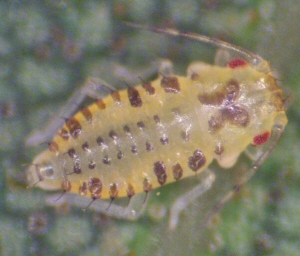Yellow Pecan Aphid
 Scientific Name
Scientific Name
Monelliopsis pecanis
Hosts
Found on pecan and hickory.
Symptoms
The most noticeable damage caused by yellow aphids is their deposits of honeydew on the foliage. Honeydew is a sticky fluid excreted by aphids, and it supports the growth of sooty mold fungi. This fungus reduces the amount of sunlight reaching the photosynthetic cells of the leaflets. Heavy spring infestations can injure a tree's vascular system and reduce chlorophyll development and leaflet size. Some studies show aphids also impair overall tree growth. Heavy late summer infestations can defoliate trees. If defoliation occurs too early in the season, from any source, nut size and fill can be adversely affected. In addition, if the leaf loss occurs too early, then the nut set for the next year can also be affected and winter injury could occur.
 Life Cycle
Life Cycle
This aphid overwinters as eggs deposited in bark crevices along the trunk and limbs. Nymphs hatch in April, move to the new spring foliage, and begin to feed. The nymphs mature in about a week and become stem mothers, which produces living young asexually throughout the rest of the summer. Many generations (15 to 30) of females are produced each year. Beginning in September, wingless females and winged males develop from some of the nymphs produced by winged females. These mate and the wingless females lay the overwintering eggs.
Description
All forms of the yellow aphid have a yellow or pale yellow background color. Unlike the black-margined aphid, they have no markings on the wings or head. The wings are held roof-like over the body when they are at rest.
Control
Please contact your local county extension office for current information.


